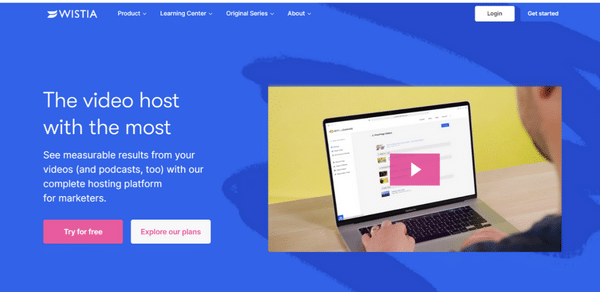As the Founder or CMO of a SaaS company, you understand how much research, resources, and hundreds of millions of dollars go into developing a product market fit for SaaS and launching it. However, after launching your SaaS product, it fails to generate enough demand to recover all expenses and efforts, resulting in poor conversion and little or no retention.
Costly disasters for your SaaS company, such as this, which reports support that 95% of product launches fail, can be corrected and revived by implementing the unbundling strategy. This post will explain why unbundling strategy is essential and how to use an unbundling strategy to fine-tune your SaaS product-market fit and revive your PMF startup product launch to increase conversion and retention. This post also includes five reminders you can use as a checklist to ensure you use the unbundling strategy correctly.
What is the Unbundling Strategy, and why should I use it?
Unbundling, as the name implies, is a method of selling a product or service separately after selling it in combination with other products. Unbundling strategy is a marketing strategy that entails following a series of steps to determine which product features you should remove to better serve a specific target customer based on customer input.
What causes most SaaS product-market fit failures and failed product launches is a one-size-fits-all approach that muddles up the core features with other features that are not reasonable or needed by the customers. As a result, customers look for more specific SaaS products that meet their needs and feel tailored to them.
The unbundling strategy assists you in fine-tuning your SaaS product offering by removing unnecessary features so that it can serve a specific audience.
How to use the Unbundling Strategy for your SaaS Business
When used correctly, the unbundling strategy can help you revive a failed SaaS product launch. Though it’s more time-consuming and labor-intensive than developing a new product-market fit, the unbundling approach ensures tremendous success because you’re launching a different version of an existing offer while maximizing customer data and feedback.
Step 1: Determine why your product-market fit for SaaS was unsuccessful.
The first and most crucial step is thoroughly examining and understanding what went wrong in your SaaS product-market fit. This step is vital for all your departments, from the product development team to the customer service team, to work together to get the product back on track rather than pass the blame.
When determining what caused your SaaS product fit to fail, it is always better to begin at the end, which is the product launch, rather than concluding that your SaaS product or product fit was a total failure.
Inquiring about the product launch and marketing strategy will help you determine whether your SaaS product fit was a failure or whether the product launch was flawed. Some questions to ask to determine if your product fit or if your product launch is the issue are as follows:
● Did I properly launch my SaaS product?
When determining the cause of a SaaS product launch failure, it’s easy to assume that your product development team did not correctly create the product fit to target the right customers. This assumption is only sometimes the case, as the product fit is most times excellent, but the product launch or marketing strategy needs to be revised.
Working with a B2B SaaS Marketing agency ensures you develop a tailored go-to-market strategy for your company to achieve its objectives.
● Was it because of my messaging?
Though most founders and CMOs overlook it, messaging used for marketing a SaaS product affects how significantly successful or productive its product-market fit will be. Since your buyers go through different stages before purchasing, regardless of how accurate your product fit is, using the wrong messaging to address the wrong audience will lead to your product launch failure.
● How can I use surveys or questionnaires to determine why the product launch didn’t work?
Customer feedback can be one of the most powerful tools in any business’s arsenal when used correctly. Surveys and questionnaires help you converse with customers and learn which features of your SaaS product they liked best and which parts they thought were unnecessary.
Feedback from your customer helps you understand the features of your product that resonate with them more and allows you to decide which parts of the product to focus on when unbundling.
These questions not only clarify whether you need to fix your SaaS product fit or the product launch, but it also provides you with more information about how customers perceive your product and how you can build on your strengths.
Step 2: Using the existing SaaS product-market fit, rebuild your product.
A lot of money and resources go into developing your product-market fit for SaaS, but if it fails, does that mean all of your efforts and time were in vain? Rebuilding a new SaaS product based on the existing product fit is a step in the unbundling strategy that ensures you use all available data and information.
After determining the source of the problem, whether it’s a poor SaaS product-market fit or a poor marketing strategy for your product launch, it is critical to use this informed data to rebuild your SaaS product.
With your informed data as the foundation for rebuilding your SaaS product, unbundling aids in the rebuilding of your product offering by;
i. Breaking it down to include features that satisfy a particular target customer instead of a one-size-fits-all approach.
ii. Developing tailored products that address and solve specific target audience pain points.
Understanding the different types of data and customer inputs that can help you rebuild your SaaS product is critical. Among them are:
- Customer feedback on the specific features or functionality of the product in which they were most interested.
- Customer service data on customers’ most common problems before declining or marking your product as irrelevant.
- Marketers’ details on the features they highlighted to deepen customers’ interest.
All of this information, when combined, provides a blueprint for all departments to follow when rebuilding the SaaS product, explicitly including what users want and unbundling features they deem unnecessary.
Step 3: Using the SaaS Minimum Viable Product (MVP) to Determine If You’re On the Right Track.
A Minimum Viable Product (MVP) is a version of a product with enough, but not all, features that are released to customers so that it can be tested and validated to provide feedback on the product’s efficiency. This step in the unbundling strategy ensures that you test and validate your rebuilt SaaS product version with your customers.
Testing and validating your SaaS MVP gives you a better understanding of how well the functionality and user integration performs with your target customers. However, if you don’t know how to test and validate your SaaS MVP, you might end up changing your SaaS product’s Unique Selling Proposition (USP).
With a better understanding of how an MVP can help you predict the success or failure of your product after launch, let’s look at the significant target audience groups for an MVP test and validation process.
i. Early Adopters; These can be existing customers or customers in your lead funnel who have problems that the product solves and have a high need for the product. This target audience is more engaged and eager to provide feedback.
ii. Subject Matter Experts; These experts analyze and provide a more detailed report on each element and its functionality. Subject matter experts who might become evangelists after using the product provide more constructive feedback because they want to see the product progress from its early stages to its final product.
With a better understanding of the significant audiences involved in the MVP validation process and which group is most relevant to testing and validating your SaaS product, let’s go over some of the most effective ways to test your MVP.

● Single feature MVP:
One of the most recommended testing strategies by MVP development companies involves testing your SaaS product’s specific robust features rather than its multiple features all at once. As a result, you narrow the customer base, and testing and development can be more focused.

● Landing page:
In this test, you dedicate a specific web page to explain your SaaS product’s main features and evaluate whether it resonates with users by asking them to join a waiting or mailing list. This testing method generates a list of interested users who are more likely to purchase your SaaS product when it launches and can serve as beta testers for usability testing.
● A/B testing:
This is a marketing strategy that involves creating two similar versions of a website, email, or landing page but with minor differences to determine which is more effective. Creating two identical web pages with the same core SaaS product offering and tweaking the product features on each page will reveal which version of your product is more accepted.
It is critical to track the activities on each page with analytics tools to determine which segment customers interacted with the most. Examples of analytics tools are Google Analytics and heatmap tools like hotjar.
● Ad Campaigns:
Platforms such as Google, LinkedIn, and Facebook help test your SaaS MVP because you can track and analyze metrics such as clicks, engagement, and other vital behaviors to provide insight into how well your product is received.

● Concierge MVP:
This test, which aids in achieving a great user experience, involves distributing your actual product to customers to determine whether they are willing to use and purchase your SaaS product. This test saves the time and money you would spend on product development.
Step 4: Reintroduce your new SaaS Product Offer.
You’ve determined the significant features your target customers want, and it’s time to relaunch your new SaaS product offer. After your initial SaaS product launch failed, let’s consider how you can boost the success of your relaunch.
I. Perfecting your Messaging:
No matter how much iteration and development has gone into your SaaS product, wrong messaging renders your efforts ineffective. To ensure proper messaging for your rebuilt product, speak in the language of your target audience and ensure your message is in front of them at the right time.
Examples of ways to perfect your messaging are;
● Targeting using social media posts and ads:
Using your target customers’ language to create ads and posts on social media helps your SaaS product resonate better with them because the product feels more tailored to their specific needs. Social media can also help you target and engage audiences similar to your target customers and have similar requirements for your product.

● Making the most of your homepage:
Since your SaaS company may not offer a single product, you may have various products listed on your homepage. Listing your newly launched product at the top navigation via a one or two-click process or the top of the homepage with an image, descriptive text, and CTA ensures you place your SaaS product in a location where interested people can easily interact with it.

● Making use of personalized email campaigns:
Mailing and waiting lists containing people who have expressed an active interest in your SaaS product are handy for perfecting your messaging. Sending tailored messages to this interested group of customers before your SaaS product launch ensures that your messaging reaches the right people.
II. Ensure a Smooth Onboarding Process:
After perfecting your messaging and driving users to your SaaS product page, engaging customers, getting them to the activation point, and making them paying customers should be as simple as possible. Here are some tips to make your onboarding process go smoothly:

● Segment your audience with a welcome screen:
To prevent different users interested in your SaaS product from perceiving your offer as a one-size-fits-all offer, you want to make it as personalized as possible using data and customer inputs gathered. You can accomplish this by using a welcome screen followed by a mini-survey to segment users and guide them to interact with the SaaS product features that are most relevant to them.

● Use checklists to accelerate user activation:
It’s easy to know which features will be most relevant to individual audiences after segmenting your audience. Using checklists allows users to engage with features that are more valuable to them more easily and quickly. Checklists should be kept short and focused on getting users from signup to the activation point.

● Use product tours or how-to-videos to provide step-by-step guides for new users:
To avoid your product market fit for SaaS being labeled as complicated by users, you must provide guidance that makes performing tasks with your product simple and requires little effort on the users’ part. You can accomplish this by producing how-to videos for your SaaS product and a series of tooltips and driven actions triggered sequentially once the user has interacted with a previous part of the product.
Step 5: Instead of developing new product-market fits, improve your SaaS product through product development.
Should you develop a new product-market fit if your SaaS product only resonates with a specific group of customers after launch?
Product development is a better and more effective approach because it’s a continuous iterative process of your SaaS product and is driven all the way through by your customers’ input. Product development helps you use feedback from your current product to create a product that will fit and resonate with a similar demographic of your target audience.
To use product development effectively, use surveys from existing users after your SaaS product launch to learn how you can;
- Restructure your offer to make it more relevant to a specific target audience.
- Create a more premium version of your SaaS product by improving the most critical features to cater to a higher-end customer base.
- Improve the product as its popularity grows.
Reminders for Using the Unbundling Strategy Effectively
● To understand why your product market fit for SaaS failed, collaborate with all departments and analyze whether your product-market fit was incorrect or the marketing strategy for the product launch was flawed.
● When rebuilding your new SaaS product, consider the current product-market fit and feedback.
● Using an MVP to test and validate your SaaS product does not require it to be fancy or feature-rich. However, it should be consistent with the actual product so that you can test and validate whether the product idea will be successful. Before launching, your SaaS MVP test must be completed and successful.
● When relaunching your SaaS product, ensure that you speak your target customers’ language and that your onboarding process is as simple and quick as possible.
● Rather than creating a new product-market fit, product development is a more effective way to increase the success of a SaaS product after its launch.
The unbundling strategy is an efficient and cost-effective way to increase demand for your relaunched SaaS product, increase conversion and retention, and recover expenses by leveraging your existing SaaS product-market fit.
Looking for a custom marketing strategy for your SaaS? Talk to an experienced team today!



